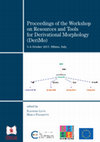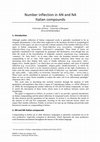Thesis Chapters by Silvia Micheli
Analisi dei meccanismi di formazione del plurale delle parole composte in due corpora di italiano... more Analisi dei meccanismi di formazione del plurale delle parole composte in due corpora di italiano contemporaneo.
Papers by Silvia Micheli
Il contributo delinea l’origine e l’evoluzione di un elemento morfologico,
mal(e)- (es. malsano, ... more Il contributo delinea l’origine e l’evoluzione di un elemento morfologico,
mal(e)- (es. malsano, malnutrito, maltrattare, malvolentieri, etc.), che da costituente di composto acquisisce gradualmente le proprietà di prefisso. Lo status di mal(e)- è descritto sulla base di dati estratti da un corpus diacronico e inquadrato nella teoria della grammaticalizzazione.
WFL is a word formation based resource for Latin where words are analysed in their formative comp... more WFL is a word formation based resource for Latin where words are analysed in their formative components and connected to each other on the basis of word formation rules. It represents a wide lexical resource for the study of Latin word formation. This paper describes how compounding is treated in the Word Formation Latin lexicon: the methodology and workflow employed to insert compound lemmas into the resource are described, as well as the reasons behind some methodological choices that have been taken during the process. Through the analysis of some types of Latin compounds, the theoretical contribution of this resource is highlighted and outlined.
Ballarè, Silvia & M. Silvia Micheli, (2018), “Usi di dove nell’italiano contemporaneo: costruzion... more Ballarè, Silvia & M. Silvia Micheli, (2018), “Usi di dove nell’italiano contemporaneo: costruzioni relative e dinamiche di ristandardizzazione”. In: LINGUISTICA E FILOLOGIA 38 (2018), 29-56.
• The goal of this paper is twofold: on the one hand, it deals with the main methodological probl... more • The goal of this paper is twofold: on the one hand, it deals with the main methodological problems related to the study of Italian compound words using linguistic corpora; on the other hand, it aims at evaluating to what extent data extracted from two corpora of contemporary Italian, which are very different in size and content, can be used to improve Italian dictionaries in regards to the inflection of Italian compounds, about which speakers often have linguistic doubts.

Recent years have seen a growing interest in research aimed at building new linguistic resources ... more Recent years have seen a growing interest in research aimed at building new linguistic resources and Natural Language Processing (NLP) tools for derivational morphology. The current increased interest in both the theoretical and applicative aspects of word formation is strictly connected to the large need for automatic semantic processing of linguistic data.
The Word Formation Latin project received funding from the European Union’s Horizon 2020 research and innovation programme under the Marie Skłodowska-Curie grant agreement No 658332-WFL. It ran from November 2015 to October 2017 and resulted in a word formation based lexicon and tool for Latin. The work was carried out at the CIRCSE Research Centre of Università Cattolica del Sacro Cuore in Milan.
The first Workshop on Resources and Tools for Derivational Morphology (DeriMo), whose contributions are collected in these proceedings, was organised to celebrate the end of the project and to consider the current status of research in the field.
This paper 1 deals with compounding from Latin to Italian. After a survey on how compounding is t... more This paper 1 deals with compounding from Latin to Italian. After a survey on how compounding is treated in the Word Formation Latin (WFL) lexicon, the fate of Latin compounds in Italian is analyzed from a morphological point of view, focusing on what of Latin Compounding (LC) has survived and what is lost. It is shown that most of Latin compounds have been totally lost or they were re-analyzed as derived or simple words. This causes a strong discontinuity between Latin and Italian compounding and a system reorganization, common to all Romance Languages, in compound word formation.
This paper describes how compounding is treated in the Word Formation Latin derivational lexicon.... more This paper describes how compounding is treated in the Word Formation Latin derivational lexicon. Through the analysis of some types of Latin compounds , perspectives and limitations of the resource are highlighted; its contribution to theoretical and computational linguistic issues is also outlined.

This paper aims at analysing a case of morphological variation in Italian, namely number inflecti... more This paper aims at analysing a case of morphological variation in Italian, namely number inflection of two types of Italian compounds: Noun-Adjective (e.g. roccaNforteA ‘stronghold’) and Adjective-Noun (e.g. mezzaAlunaN ‘half-moon’) compounds. These compounds display both double inflection (e.g. cassePLfortiPL ‘safes’, doppiPLvetriPL ‘double glasses’), and external inflection (e.g. roccaSGfortiPL ‘strongholds’, doppioSGpettiPL ‘double-breasted’). Furthermore, in some cases the same compound shows both kinds of inflection, i.e. ‘overabundance’ (Thornton 2012). The analysis of both quantitative and qualitative data from a corpus of Contemporary Italian (i.e. itWaC) reveals that NA compounds do not show a consistent behavior in number inflection, since they are in general ancient and infrequent forms which originate in syntax and, in some cases, undergo lexicalization. On the other hand, AN compounds represent a morphological pattern mostly consisting of (sometimes still productive) series which display a transparent internal structure and a strong tendency to double inflection. Moreover, it appears from the examined data that although in most cases each compound seems to need an ad hoc explanation, frequency (especially for NA compounds) and belonging to a series (for AN compounds) can be considered as the most relevant factors for determining inflection.
Federigo Bambi (redattore, Firenze) -Marcello Barbato (Napoli) Piero Fiorelli (Firenze) -Giovanna... more Federigo Bambi (redattore, Firenze) -Marcello Barbato (Napoli) Piero Fiorelli (Firenze) -Giovanna Frosini (Siena) Max Pfister (Saarbrücken) -Wolfgang Schweickard (Saarbrücken) PROPRIETÀ LETTERARIA RISERVATA Gli articoli proposti per la pubblicazione sono sottoposti al parere vincolante di due revisori anonimi.








Uploads
Thesis Chapters by Silvia Micheli
Papers by Silvia Micheli
mal(e)- (es. malsano, malnutrito, maltrattare, malvolentieri, etc.), che da costituente di composto acquisisce gradualmente le proprietà di prefisso. Lo status di mal(e)- è descritto sulla base di dati estratti da un corpus diacronico e inquadrato nella teoria della grammaticalizzazione.
The Word Formation Latin project received funding from the European Union’s Horizon 2020 research and innovation programme under the Marie Skłodowska-Curie grant agreement No 658332-WFL. It ran from November 2015 to October 2017 and resulted in a word formation based lexicon and tool for Latin. The work was carried out at the CIRCSE Research Centre of Università Cattolica del Sacro Cuore in Milan.
The first Workshop on Resources and Tools for Derivational Morphology (DeriMo), whose contributions are collected in these proceedings, was organised to celebrate the end of the project and to consider the current status of research in the field.
mal(e)- (es. malsano, malnutrito, maltrattare, malvolentieri, etc.), che da costituente di composto acquisisce gradualmente le proprietà di prefisso. Lo status di mal(e)- è descritto sulla base di dati estratti da un corpus diacronico e inquadrato nella teoria della grammaticalizzazione.
The Word Formation Latin project received funding from the European Union’s Horizon 2020 research and innovation programme under the Marie Skłodowska-Curie grant agreement No 658332-WFL. It ran from November 2015 to October 2017 and resulted in a word formation based lexicon and tool for Latin. The work was carried out at the CIRCSE Research Centre of Università Cattolica del Sacro Cuore in Milan.
The first Workshop on Resources and Tools for Derivational Morphology (DeriMo), whose contributions are collected in these proceedings, was organised to celebrate the end of the project and to consider the current status of research in the field.